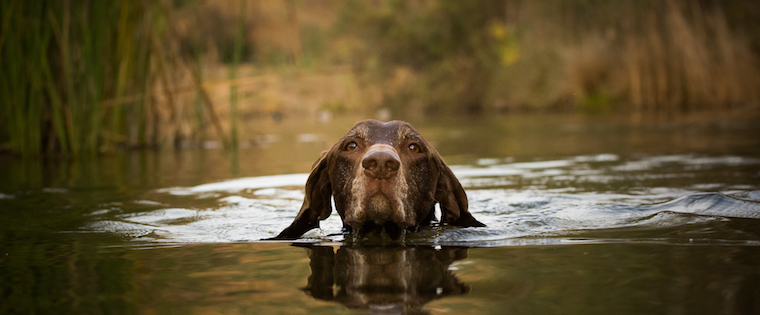Some of us have dogs who take to the water immediately: they jubilantly jump in, swim joyfully, and can hardly be kept out of the water. Others have dogs who will tolerate swimming when required, but generally avoid it. And then some of us have stubborn dogs who throw on the brakes near water, won’t go in, and don’t know how to swim. For these water-phobic dogs, should you teach them how to swim? And what about those dogs who seem to love the water, but are prone to sink…can they learn too?
Can all dogs swim?
First, let’s clear this up: not all dogs can swim. Some breeds, like those with barrel chests and/or short legs (think English Bulldogs and Pugs) cannot swim. If you toss them in the water, they’ll sink. Other dogs don’t naturally know how to swim. So test the waters with your dog first before assuming she wants to swim with you.
Why and how to teach a dog to swim
If you have a pool, a boat, or spend a lot of time on a beach, you should teach your dog to swim (for those breeds that cannot swim, see below about life jackets). If your dog naturally runs into the water and starts swimming, then you can skip the swim lessons. But when your puppy is first introduced to water, or if your shy and uncertain dog doesn’t seem to know what to do or is scared, you’ll have to play a role in teaching him to swim.
This American Kennel Club article offers some tips for how to teach your dog to swim. The basics: start in the shallow end, put out toys as an incentive, support your dog underneath until she figures out how to use all four legs to paddle, and offer treats and praise for her efforts. Once she realizes how to use four legs, and that swimming is fun, she should start swimming on her own.
Tips for swimming with dogs
Now that your dog knows how to swim, she may join you every time you jump in. Make sure that before swimming, you teach your dog how to get out of the water. In a pool, this means having a ramp or accessible ladder that your dog can access by himself. Off a boat, this means having a plan for helping the dog back on (life jackets have handles that help with this immensely). Know for sure how the dog will get back on dry land before you allow him to swim.
Your dog should also follow commands, like “come,” when swimming. If your dog doesn’t listen well, have treats or toys available to bribe dogs to come back from swimming too far away or into dangerous areas. Your dog also needs to know not to swim up to you while you’re in the water. Eighty pounds of wet dog on your shoulders will make you sink, so teach your dog not to come too close to you in the water.
Be smart about changing water conditions. Like humans, dogs will tire out trying to swim in difficult tides or currents. Watch for fatigue and get out of the water if conditions seem dangerous. Even if the water is calm, take plenty of breaks for water and rest.
Finally, never let a dog swim unsupervised.
Does my dog need a life jacket?
As mentioned earlier, if your dog is of a breed that cannot swim, or if you’ve tried swimming and he is clearly not interested or able, then you need to get a life jacket for water-based activities. Even if your dog can swim, use a life jacket for tiny dogs and dogs with short legs (they will tire easily when swimming) and for any dog on a boat that spends time in deep, isolated water. Just as with humans, you don’t want to assume that even a strong swimmer could keep it up for a long time if an emergency happened. It’s better to be safe than sorry, so regular boaters should keep their dogs in personal flotation devices.
In general, treat your dogs in the water like children: make sure they know how to swim, use life jackets regularly, don’t let them swim alone or swim far from the crowd, and take lots of breaks. Now go have fun! And if you have any questions about your dog’s ability to swim, health or other issues, contact Pine Street Animal Hospital today.



